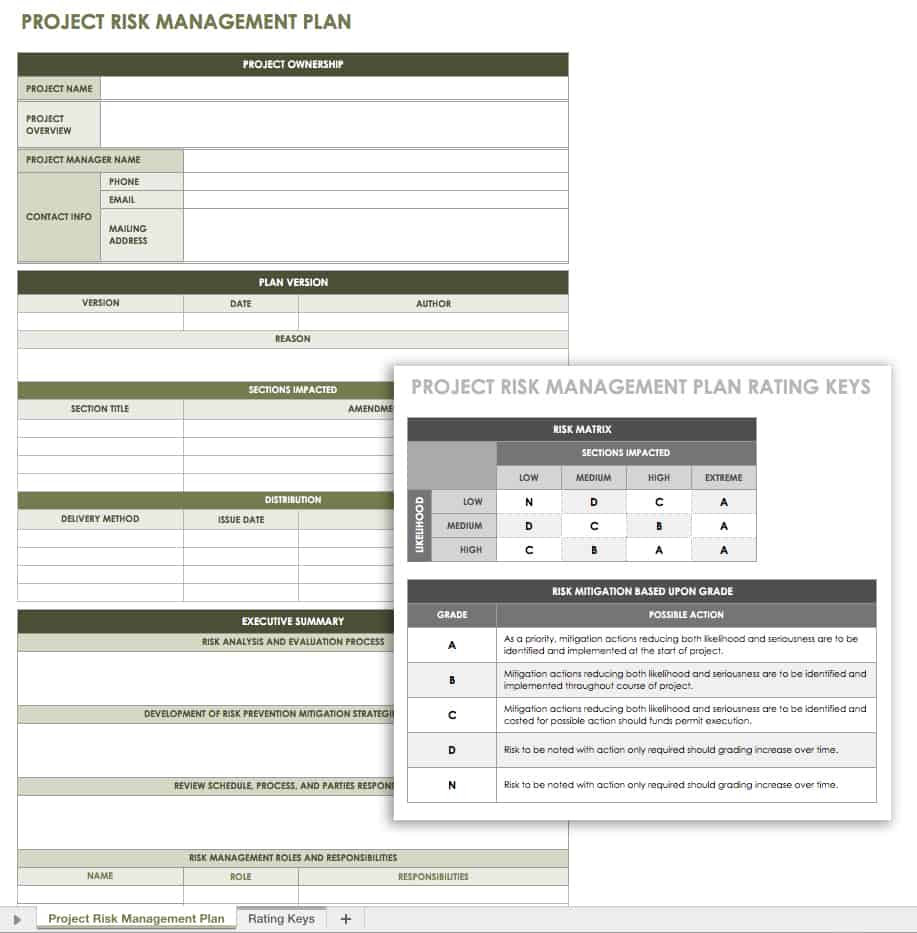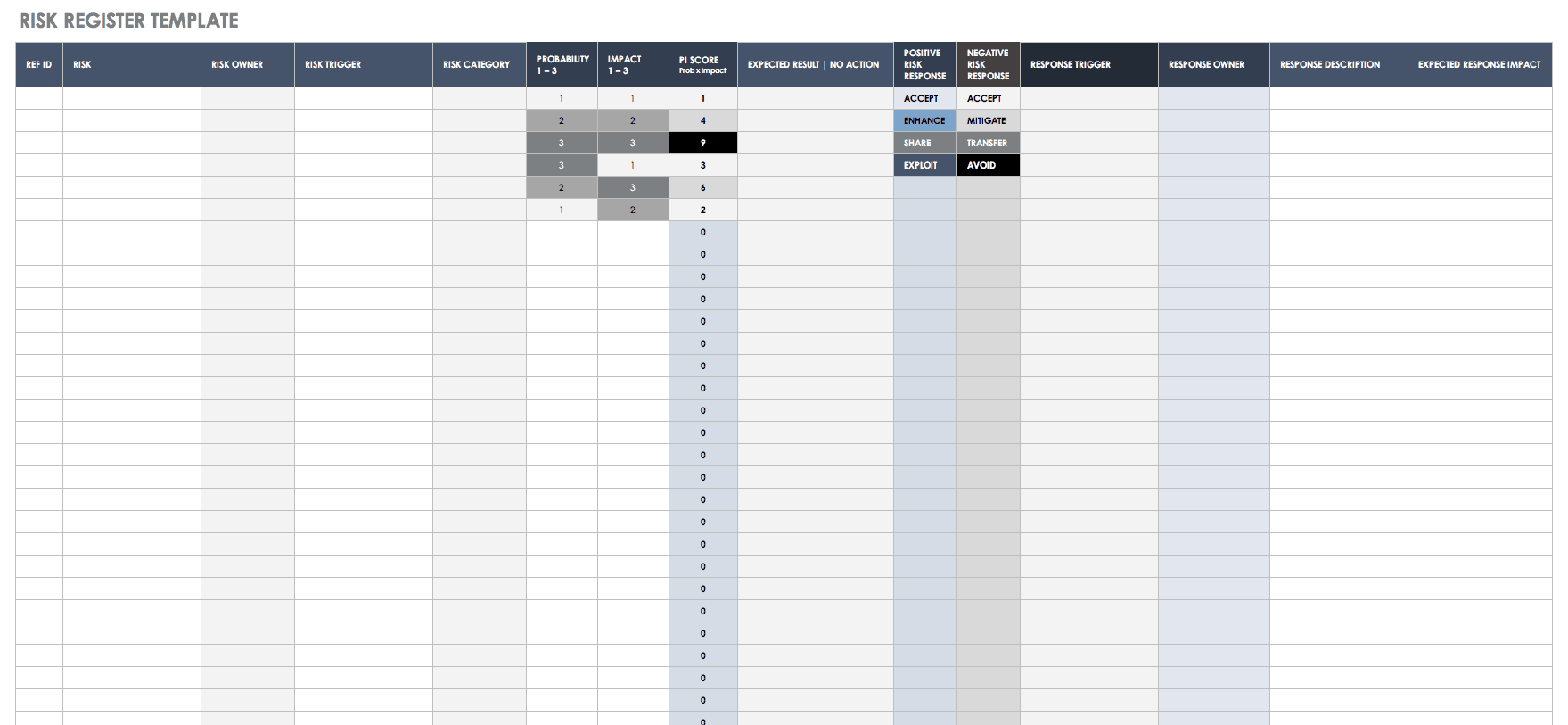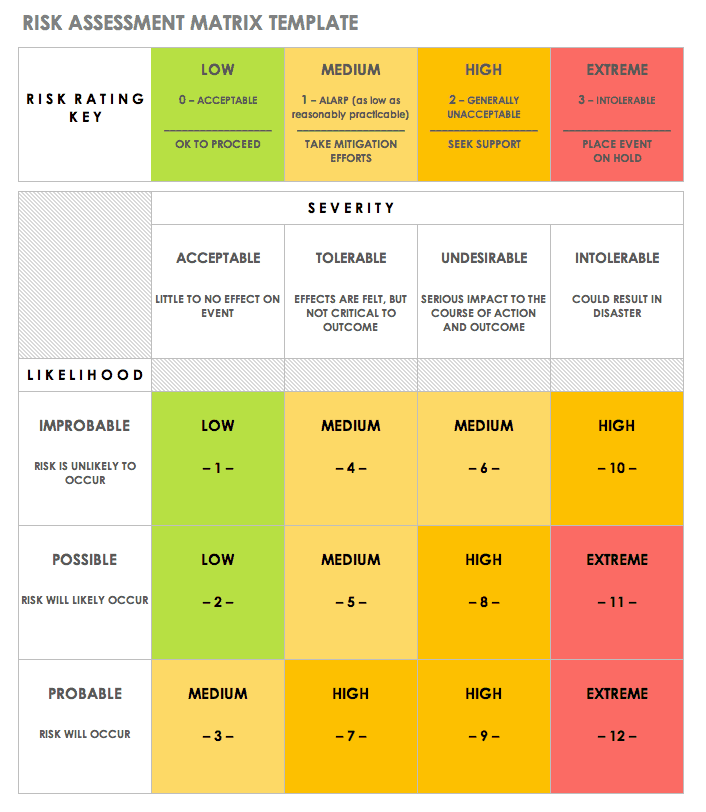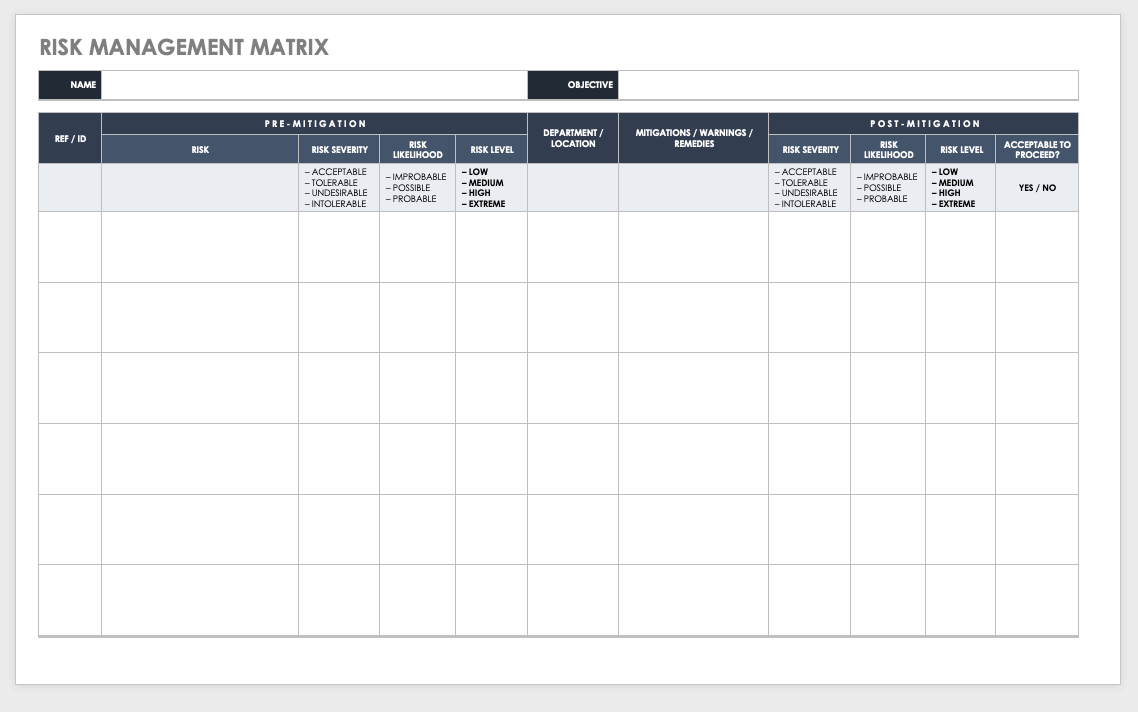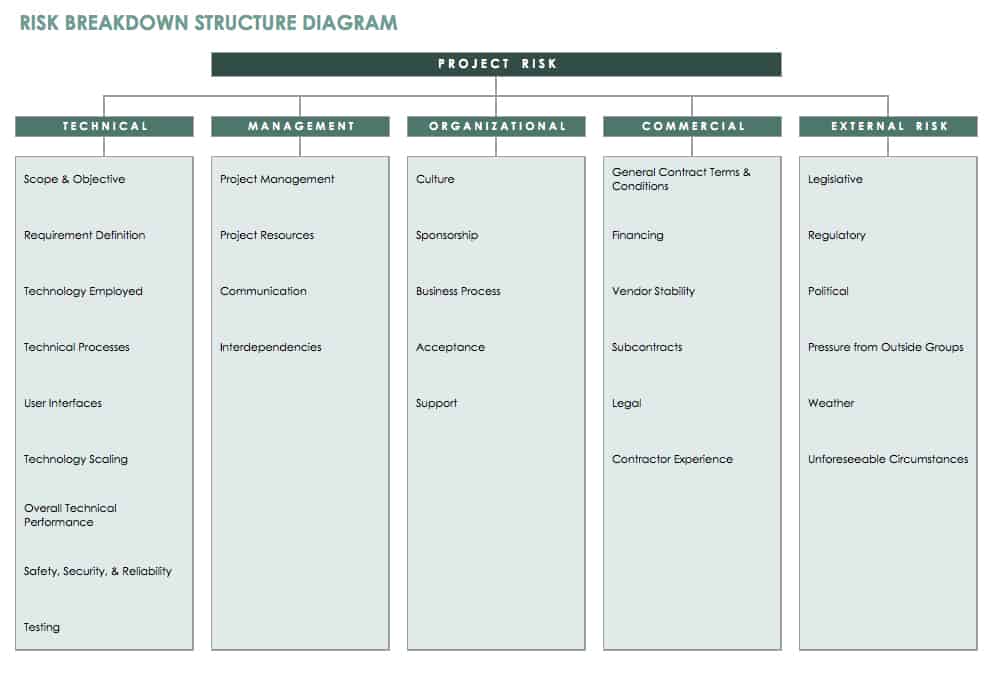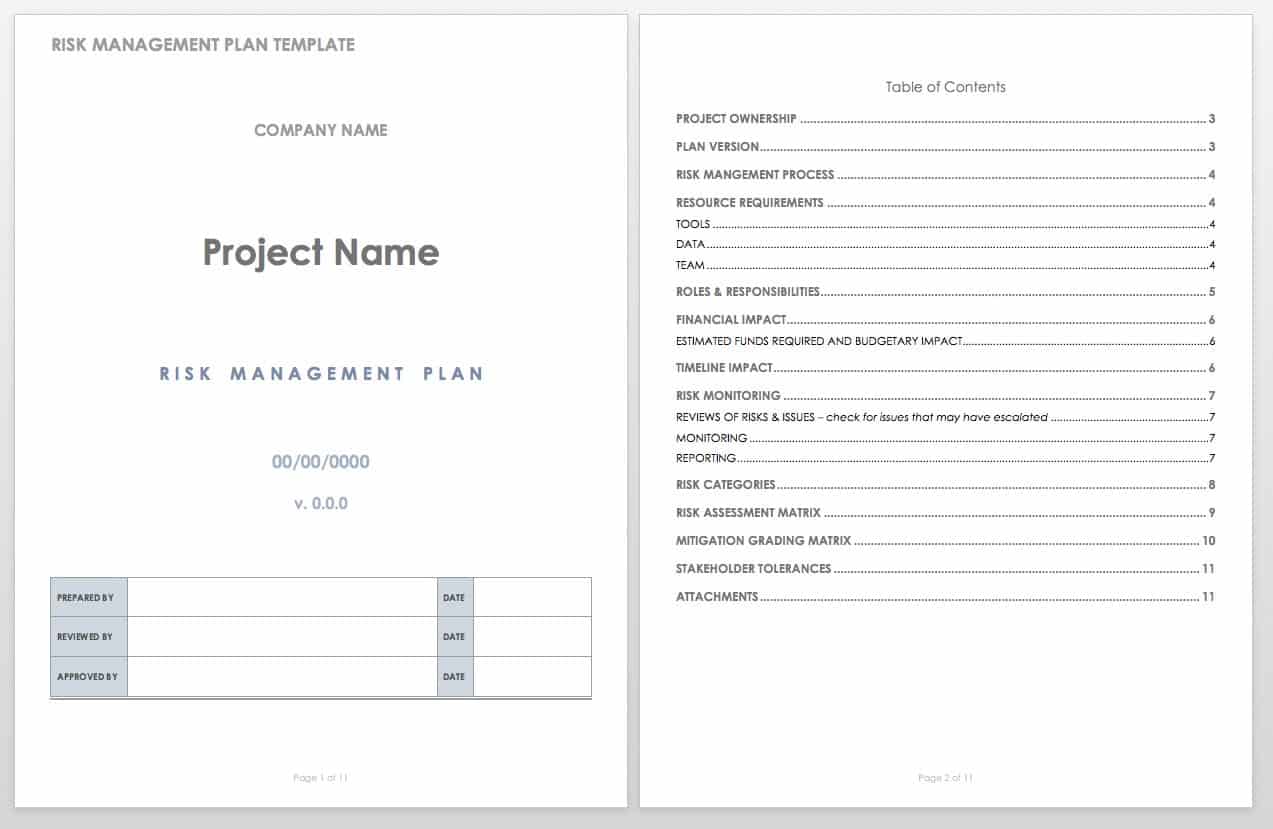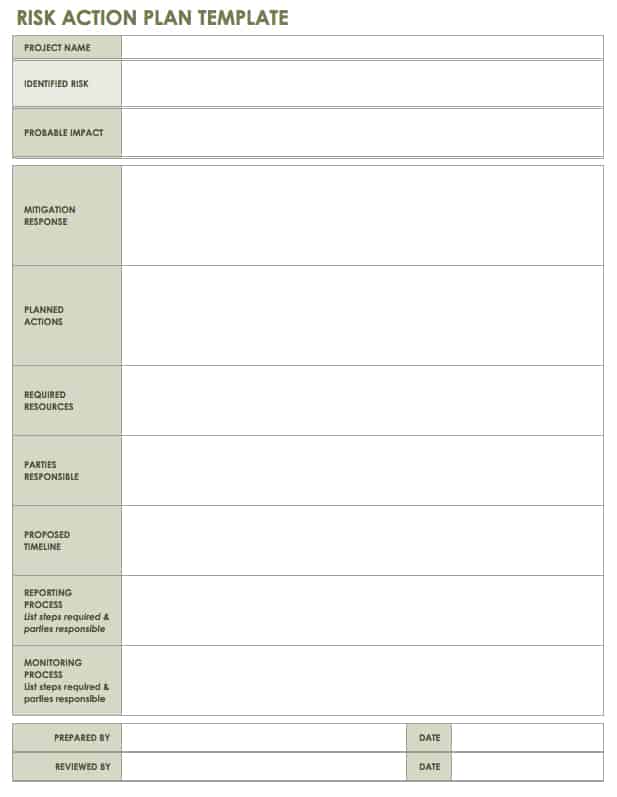Risk Management Planning Templates for Excel
Project Risk Management Plan Template
This template allows you to create a project risk management plan for Excel, which may be helpful for adding any numerical data or calculations. You include typical sections in the template, such as risk identification, analysis and monitoring, roles and responsibilities, and a risk register. Add or remove sections to create a customized template for your project.
Download Project Risk Management Plan Template
Risk Register Template
On this risk register template, you include project details at the top and list risks below with assigned tracking numbers. The register provides a detailed log of who owns a risk, the level of impact and probability, planned actions, and the response status. This is a spreadsheet template that can be easily edited to include additional columns if needed.
Download Risk Register Template
Risk Assessment Matrix
This simple matrix template is designed to aid the assessment process, providing a quick view of the relationship between the likelihood of occurrence and the severity of impact, as well as the number of risks that fall into each category. The color scheme makes it easy to distinguish among the different ratings, so you can get an overview of the levels of risk that need to be addressed.
Download Risk Assessment Matrix
Excel | Word | PDF | Smartsheet
Risk Management Matrix
For some smaller projects, you may only need to use a risk management matrix (rather than create a lengthy management plan). You can also use this matrix template, in addition to a detailed plan, to organize vital information in a single spreadsheet. The template includes a risk assessment matrix for getting an overview of risk ratings, plus a management matrix for identifying and assessing risks, describing mitigation strategies, and monitoring control efforts.
Download Risk Management Matrix
Excel | Word | PDF | Smartsheet
Risk Breakdown Structure Diagram
You can use this template to create an RBS diagram based on the risks involved at the different stages of a project’s work breakdown structure. You can also use the RBS template to organize risks by category by breaking down internal risks into subcategories, such as technical or organizational, and distinguishing them from external risks. This is a helpful tool for organizing risks visually and listing them in the risk register.
Download Risk Breakdown Structure Diagram
Other Risk Management Templates
Risk Management Plan Template - Word
This risk management plan sample offers a basic layout that you can develop into a comprehensive plan for project or enterprise risk management. It includes a matrix for viewing probability and impact as well as sections for describing a risk management approach, budgeting, scheduling and reporting protocols, and more.
Download Risk Management Plan Template
Risk Action Plan Template
An action plan template allows you to go into detail about proposed actions for a specific risk. This PDF template offers a simple layout with sections for describing the risk and recommended response, defining an action plan, listing required resources, assigning responsibility, and setting a timeline for completion.
Download Risk Action Plan Template
Project Risk Management
The Project Management Body of Knowledge (PMBOK® Guide, 5th Edition) defines project risk as “an uncertain event or condition that, if it occurs, has a positive or negative effect on one or more project objectives, such as scope, schedule, cost, or quality.” Notice that these risks can be considered positive or negative depending on their effects. Project risk management seeks to maximize positive risks while avoiding or mitigating negative risks. A risk management plan is typically included as part of a larger project plan, and is initiated early in the project lifecycle; the risk plan then evolves as the project progresses. It is generally the project manager’s role to maintain the plan and update it periodically to ensure ongoing clarity and effectiveness.
The overall goal of a risk management plan is to manage risk in a way that ensures a successful project outcome. The planning process enables managers to clearly identify risks, and then develop and document risk mitigation strategies and contingency plans. The process also includes identifying both the costs and actions necessary for implementing the plan. Once completed, the plan serves as a guide for everyone involved in a project and is particularly important as a tool to communicate with key stakeholders.
Ways to Handle Risk
Once you’ve identified and evaluated a risk, there are several potential responses. The response you choose will depend on the probability of the risk occurring and the potential severity of its impact on a project.
- Avoid: Avoiding risks is ideal, and especially important if the risk is high impact and likely to occur. Avoidance tactics may require greater investment (in order to develop alternative strategies), but this additional cost and effort is appropriate for high-impact, high-probability negative risks.
- Transfer: This method refers to transferring risk to another party (for example, the act of purchasing insurance moves the risk to the insurance provider). This response is common for risks that have a high negative impact but a low probability of occurring.
- Mitigate: Mitigation aims to reduce either the likelihood or the level of impact of a risk, and is used for risks that are likely to occur, but also likely to be low-impact.
- Accept: Acceptance is an option when there is no other solution, but would only be used for low-impact risks that have a low probability of occurring.
Risks can be internal or external, and projects may face a combination of both. Internal risks may include issues with technology, staffing, financial security, and other factors that can be controlled within your organization. External risks can be harder to predict and control, and may include factors such as issues with suppliers, changes in the political climate or economy, or even the weather. The process of analyzing risks and measuring them on a scale of probability and severity can provide the initial framework for determining which of the above methods will be the most effective response to a given risk.
Risk Management and HIPAA Compliance in Healthcare Organizations
Healthcare organizations are under strict regulations when it comes to risk and compliance. That’s why the ability to determine where those risks exist and establish a plan to manage them is extremely important for the business, both legally and functionally.
Risk management for healthcare organizations helps to ensure the all businesses are compliant with HIPAA requirements, and outlines potential risks that could occur in a healthcare organization, such as clinical testing errors, hospital facilities issues, security breaches of protected health information PHI, and more. To ensure that all healthcare data is effectively analyzed for security and protection purposes, you need a tool that is able to quickly identify, mitigate, and prevent risks from coming to fruition, while also offering real-time visibility into all potential risks.
Smartsheet is a work execution platform that enables healthcare companies to view and update risks across the company with real-time dashboards, so you can make the best decisions at the right time. Highlight all identified risks and manage how they are addressed, all while ensuring utmost security and protection of PHI. Set sharing settings to ensure that only authorized users have access to confidential information, so your organization remains compliant with HIPAA regulations.
Interested in learning more about how Smartsheet can help you accurately and securely document healthcare processes and maximize your efforts? Discover Smartsheet for Healthcare.
Example of Risk Management Plan Outline
The length and level of detail included in a risk management plan will vary depending on the scope of a project and the needs of an organization. Here is a risk management plan example outline that describes the information you typically include:
- Introduction: The first section in a risk management plan may focus on an executive summary or project description, including the purpose of the project. It may go into detail about the scope of the project, objectives, and important background information, and provide an overview of risk management approach and strategies.
- Risk Management Approach: This may be a brief summary or detailed section providing information on the risk management process, the methodology used, and specific tools and techniques to be utilized.
- Roles and Responsibilities: Here you list the project staff members involved in the risk process, along with each of their roles and responsibilities.
- Risk Identification: This section describes how you will identify risks and/or lists risks that you have already found. Methods for risk identification may include brainstorming, examining the project’s work breakdown structure (WBS) in order to identify risks and create a corresponding risk breakdown structure (RBS), conducting expert interviews, consulting with key stakeholders, or reviewing common risks from similar projects.
- Risk Analysis and Evaluation: You must analyze risks that you identify to determine what effects they might have on a project, such as a delayed timeline or reduced quality. You must also evaluate these risks for probability and impact. This section may describe how probability of occurrence and impact are calculated and combined to create a numeric score for each risk. Here, you can also define the categories and terms you use to describe the different levels of probability and impact. In addition, if you’ve determined top risks, you can list them here.
- Risk Response Planning: You can explain the process for conducting response planning here, including how a project team will develop actions to address both negative and positive risks.
- Risk Mitigation: You can list potential risk mitigation strategies here, connecting possible actions to risks based on the level of seriousness. This section may also consider important risks that you have identified, providing detail on what type of mitigation you’ve proposed, ownership for implementing the action, and cost implications.
- Risk Monitoring and Reporting: This section may describe how you will monitor risks, the frequency of reviews, how you will identify new risks, and the method and schedule you will use for reporting.
- Risk Register: Also called a risk log, the register typically appears at the end of a risk management plan, or as a separate document. The register tracks important details about each risk including probability, impact, overall score, and status. It essentially combines the results from risk analysis and response planning into a spreadsheet or chart for easy reference.
You will need to adjust the content and formatting of this example plan to meet the needs of your business or project. To see how others have handled this process for similar projects, you can search for sample risk management plans online and compare different approaches. Comparing project risk management plan examples may save you time in the long run, especially if you are new to the process. To use the free templates provided below, simply download your chosen file, and make any required edits.
Create a Powerful Risk Management Plan With Smartsheet
Empower your people to go above and beyond with a flexible platform designed to match the needs of your team — and adapt as those needs change.
The Smartsheet platform makes it easy to plan, capture, manage, and report on work from anywhere, helping your team be more effective and get more done. Report on key metrics and get real-time visibility into work as it happens with roll-up reports, dashboards, and automated workflows built to keep your team connected and informed.
When teams have clarity into the work getting done, there’s no telling how much more they can accomplish in the same amount of time. Try Smartsheet for free, today.
Any articles, templates, or information provided by Smartsheet on the website are for reference only. While we strive to keep the information up to date and correct, we make no representations or warranties of any kind, express or implied, about the completeness, accuracy, reliability, suitability, or availability with respect to the website or the information, articles, templates, or related graphics contained on the website. Any reliance you place on such information is therefore strictly at your own risk.
These templates are provided as samples only. These templates are in no way meant as legal or compliance advice. Users of these templates must determine what information is necessary and needed to accomplish their objectives.
